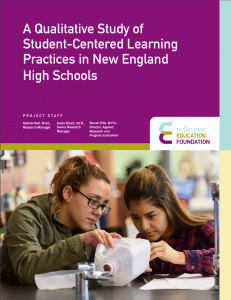How are We Doing Implementing Student-Centered Learning?
CompetencyWorks Blog
 Nellie Mae Education Foundation (NMEF) and the Donahue Institute at University of Massachusetts released a new report A Qualitative Study of Student-Centered Learning Practices in New England High Schools last month. Student-centered learning as defined by NMEF has four tenets: (1) learning is personalized; (2) learning is competency-based; (3) learning takes place anytime, anywhere; and (4) students take ownership. There are a number of findings that we should pay attention to:
Nellie Mae Education Foundation (NMEF) and the Donahue Institute at University of Massachusetts released a new report A Qualitative Study of Student-Centered Learning Practices in New England High Schools last month. Student-centered learning as defined by NMEF has four tenets: (1) learning is personalized; (2) learning is competency-based; (3) learning takes place anytime, anywhere; and (4) students take ownership. There are a number of findings that we should pay attention to:
How Can We Make Adoption of CBE Easier?
Finding: Schools tended to report that the adoption of competency-based learning (CBE) models is more challenging than implementation of other tenets. Educators and leaders face considerable barriers to successful implementation, such as expectations that students will advance at the end of each school year and community concerns regarding colleges’ views of competency-based transcripts.
Discussion: Based on my experience visiting schools, everything goes easier once schools embrace a new set of values and assumptions led by the number one tenet – Do What’s Best for Kids. (See Courtney Belolan’s article on culture.) Some people argue that we need discrete models with options for specific practices. What do you think would make adoption easier?
Do We Have Enough Results Yet to Begin to Determine What Works?
Finding: Every site visit school implemented a unique competency-based learning system. The lack of a proven competency-based model challenges schools to invent their own approach.
Discussion: I will still argue that we are early in the process of innovation and that we are still finding our way to figuring the “best models.” However, we are also now at the stage of districts and schools having several years of implementation. So we should begin to benchmark different models and practices that are yielding results?
What Will It Take to Increase Expanded Learning Opportunities?
Finding: Anytime/anywhere learning practices lag behind the other SCL tenets. Teachers and administrators face an array of challenges to implementing approaches within this tenet, such as establishing community partnerships, transportation, and budget. Some schools appear not to realize the full educational potential of such practices.
Discussion: In this case, anytime/anywhere refers to expanded learning opportunities in the community, not 24/7 digital learning. There have been so many efforts to increase real-world learning, such as school-to-work and service learning. Can we build upon other efforts? Can we learn from California’s Connected Learning efforts that looked at how to maximize experiences in the community?
Should We Think About Transitional Phases for District Schools Shifting to SCL and CBE as Compared to Start Ups?
Finding: In contrast to study charter schools, all of the traditional high schools in the study operated for decades in conventional educational frameworks before beginning to embrace student-centered practices. Respondents at every traditional site visit school expressed that shifting toward a vision of student-centered learning prompted pushback from an array of constituents.
Discussion: There is always pushback from constitutents when it comes to public education because different stakeholders have different interests. Can we better support district and school leaders to build community engagement and communication strategies to address different stakeholder concerns? Are there phases in making this transition to CBE that raise different questions and concerns?
What is the Purpose of School? Covering Standards or Helping Students to Learn
Finding: There was consensus among many teachers that instruction in a student-centered classroom takes longer than in a conventional learning environment. Many teachers opt to use conventional teaching methods at times due to the pressure to teach students the content required for standardized tests and Advanced Placement exams.
Discussion: This was the most interesting of the findings. Why does student-centered instruction take longer? Perhaps because it takes longer for students to learn things than we anticipate in a standards-packed semester. Perhaps because once you take into consideration the pre-requisite skills students need for a grade-level task, there is more learning taking place. Perhaps because other instructional strategies than the teacher-led conventional are new to teachers and they need to develop their skills. This finding calls for us to start thinking about effectiveness and cost-effectiveness of different instructional strategies in the context of helping student.
Thanks to NMEF and Donahue Institute for gathering these insights!
See also:
- Seizing the Moment
- Competency Education Can Address Readiness Gaps—But Not Alone
- Going International: A Report from Mexico on Competency Education